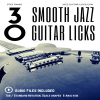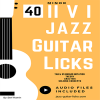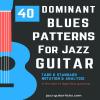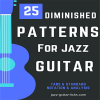
Triads On Guitar - Lesson With Tabs & Shapes
- By jazz-guitar-licks
- On 2018-10-08
- 8 comments
Triads are one of the first harmonic tools to study. They are very useful for comping and chordal enrichment.
Learning close and open (aka spread) triads increase your harmonic knowledge and at the same time help you discover your fretboard.
In this lesson you will see the main triad chord shapes including root positions and inversions.
You will also find some ideas on how to use triads over a II V I sequence, in order to create interesting melodic movement in your comping.
What Are Triad Chords?
Here is a brief introduction. A harmonic triad is a combination of three notes (root, third and fifth) stacked vertically in thirds.
After having read all that follows, you should be able to spell the four qualities of triads and play them in root positions and inversions whatever the key.
There are four main types of triads, you'll find them below.
Difference Between Triad and Dyad
A dyad is made of two notes whereas a triad is built with three notes.
Major Triads
Major triads are built by stacking three notes in thirds.
You can also think of them as a one major third and one minor third stacked on each other.
Interval pattern is R - 3 - 5. C major triad is represented below.

Minor Triads
Minor triads are made up of two thirds, one major third and one minor third.
Interval pattern is R - b3 - 5. You can see a D minor triad below.

Diminished Triads
Diminished triads are made up with a root (1), a minor third (b3) and a diminished fifth (b5).
As you can see with D diminished below, they are built by stacking two minor thirds

Augmented Triads
An augmented triad is built with two major thirds stacked. The interval pattern is 1 - 3 - #5.
As its name implies it contains an augmented fifth. C augmented is shown below.

Triads Within the Major Scale
One of the fundamental theoretical elements is to know how to harmonize the major scale in thirds in order to obtain seven triads built on each degree.
By stacking thirds on each interval of a major scale, you get three major triads (degrees I, IV and V), three minor triads (degrees II, III and VI) and a diminished triad on the VII degree.
| Degrees | I | II | III | IV | V | VI | VII |
| C major scale | C | D | E | F | G | A | B |
| Triads | C | Dm | Em | F | G | Am | Bdim |
There is no augmented triad in the harmonization of the major scale. So, they will not be used in the exercises below.
Please note that augmented triads can be found on the harmonized degree III of the harmonic minor scale, on the sixth degree of the harmonic major scale and on the third degree of the melodic minor scale.
Close Triads and Inversions
Before learning how to use triads over a II V I sequence, here are some triad guitar shapes that will serve as the basis for the exercises below (except augmented forms).
All the triads below are closed voiced, meaning that all the notes are placed as close together as possible, they are all included in one octave.
Each triad produces two inversions with third or fifth in the bass. Each neck diagram provides three possibilities to play a triad.

Major Triad - Close Voicings
| Major triad Root voicing | R | 3 | 5 |
| 1st inversion (third in the bass) | 3 | 5 | R |
| 2nd inversion (fifth in the bass) | 5 | R | 3 |
Minor Triad - Close Voicings
| Major triad Root voicing | R | b3 | 5 |
| 1st inversion (minor third in the bass) | b3 | 5 | R |
| 2nd inversion (fifth in the bass) | 5 | R | b3 |
Diminished Triad - Close Voicings
| Major triad Root voicing | R | b3 | b5 |
| 1st inversion (minor third in the bass) | b3 | b5 | R |
| 2nd inversion (diminished fifth in the bass) | b5 | R | b3 |
Augmented Triad - Close Voicings
| Major triad Root voicing | R | 3 | #5 |
| 1st inversion (third in the bass) | 3 | #5 | R |
| 2nd inversion (augmented fifth in the bass) | #5 | R | 3 |


Open Triads (aka Spread Triads) and Inversions
To build an open triad, just take the middle note of an open triad (the 3rd) and move it an octave higher. Open triads are also called "spread triads".
They can be very useful for composition or arrangement and also very helpful to explore the guitar neck more in-depth.
As shown below, each triad generates three open shapes including a root voicing and two inverted voicings.

Concerning the diagrams below, root voicings are represented in blue, 1st inversions are in red and 2nd inversions are in green.
Please note that some of the shapes are a little bit stretchy, don't hesitate to experiment your own positions.
Major Triad - Open Voicings
| Root voicing (root in the bass) | R | 5 | 3 |
| 1st inversion (third in the bass) | 3 | R | 5 |
| 2nd inversion (fifth in the bass) | 5 | 3 | R |
Minor Triad - Open Voicings
| Root voicing (root in the bass) | R | 5 | b3 |
| 1st inversion (minor third in the bass) | b3 | R | 5 |
| 2nd inversion (fifth in the bass) | 5 | b3 | R |
Diminished Triad - Open Voicings
| Root voicing (root in the bass) | R | b5 | b3 |
| 1st inversion (minor third in the bass) | b3 | R | b5 |
| 2nd inversion (dim. 5th in the bass) | b5 | b3 | R |
Augmented Triad - Open Voicings
| Root voicing (root in the bass) | R | #5 | 3 |
| 1st inversion (third in the bass) | 3 | R | #5 |
| 2nd inversion (augmented fifth in the bass) | #5 | 3 | R |




Triads Within Seventh Chords
Now let's get to the essential point of this lesson : How to extract triads from seventh chords in order to use them over a common progression used in jazz, the II V I sequence.
The first reflex would be to take the first three notes of each tetrad chords which, are obviously triads.
Remember that tetrad chords are actually triads with an additional note that can be a minor seventh (b7) or a major seventh (7). But, playing these triads don't have much interest.
In order to get more intersting colors, we'll take three seventh chords (minor 7, major 7 and dominant 7) representing the degrees II, V and I of the sequence we need and extract the triads starting on the third of each 7th chord. This is what we call a "diatonic substitution".
When taking the three highest notes of a minor seventh chord we obtain a major triad.

When taking the three highest notes of a dominant seventh chord we get a diminished triad.

When taking the three highest notes of a major seventh chord we get a minor triad.

Exercise 1
This first II V I progression uses three triads in close positions involving three root voicings (not inverted).
So, we get Fmaj over Dm7, Bdim over G7 and Emin over Cmaj7.

Exercise 2
In this example you see three triad voicings in their first inversion. The first major triad over Dm7 can be renamed Fmaj7/A.
The second triad can be written Bdim/D and the third triad over CMaj7 can be named Em/G.

Exercise 3
This example takes three inverted triads. One important things when comping with triads, is to avoid unnecessary hand displacement on the guitar neck.
You see below that the positions are very close to each other.

Exercise 4
This example requires mixing two inverted voicings over Dm7 and Cmaj7 and a non-inverted one over G7.
Once again the triad positions are close to each other.

Exercise 5
Two inversions and one root voicing are used in it.

Exercise 6
This exercise is to play open triads using two root voicings over G7 and Cmaj7 and an inverted one over Dm7.
You see that Fmaj and Bdim share one note (F) as Bdim and Emin (B).

Exercise 7
This one requires the use of two inverted open triads.

Exercise 8
Three root voicings are used here.

Triads, although they contain only three notes, must not be ignored because they can be very interesting when intelligently used. As you can imagine there are a lot of combinations.
Don't hesitate to experiment your own positions and try to mix open and close voicings in order to comp over your favorite jazz progressions.
-
Guitar Scale Dictionary
This E-book is a printable PDF method including over 700 scale diagrams and formula charts for guitarists. -
Guitar Chord Dictionary
This PDF eBook provides over 550 guitar chord shapes. This is the perfect reference guide to understand how chords are built and how to play them on the guitar neck. -
30 Groovy Jazz Guitar Licks
This downloadable package contains a PDF WITH audio files giving access to 30 groovy guitar phrases mixing jazz, blues and funky licks for beginners. -
172 Arpeggio Shapes For Guitar
This printable PDF is a method dedicated to guitarists of all styles who want to learn build and play the most important types of arpeggios. -
126 Triad Chord Shapes
This handbook for guitar players is intended both for teachers and students. It includes 126 guitar shapes for mastering triads. -
Major Scale Harmonization
This package provides a printable PDF with exercises and audio files to learn how to harmonize the major scale with 3 note chords and their extensions. -
30 Minor Arpeggio Licks
This package includes a printable PDF method containing 30 exercises with tabs, staves and audio files for practicing minor arpeggios on guitar. -
II V I Bundle - 170 Exercises
This bundle contains 4 PDF methods for a total of 170 exercises with tabs, staves, analysis & audio files for practicing scales, arpeggios licks & chords over the 2-5-1 progression. -
Diatonic Licks Bundle
This package contains 120 jazz guitar lines based on diatonic modes as Mixolydian, Dorian and Ionian. PDF format with tabs, audio files and analysis. -
30 Smooth Jazz Guitar Licks
In this package you'll get a printable PDF Method with tabs, notation, analysis, scale shapes and audio files for practicing 30 smooth jazz guitar licks. -
40 II V I Jazz Guitar Licks
This pdf method for guitar contains fourteen 2 5 1 jazz guitar lines with tab, standard notation, analysis, scale charts and audio files. -
50 II-V-I voicings
This printable PDF guitar method provides 50 exercises with audio files, analysis, tab and staves for learning major 2-5-1 chord voicings. -
40 Minor 2 5 1 Chord Voicings
This PDF method contains 40 exercices with tabs, scores and audio files for practicing jazz guitar chords over the minor 2 5 1 progression. -
40 Minor II V I Licks
This guitar method is a printable PDF with tabs, diagrams, theory and audio files providing 40 minor 2 5 1 jazz patterns. -
40 Mixolydian Jazz Guitar Lick
PDF guitar method with tabs, audio files and theory providing 40 dominant jazz guitar lines for teachers and students. -
40 Minor Jazz Guitar Licks
This printable guitar method in PDF format contains 40 easy minor jazz guitar lines based on the Dorian mode. -
40 Major Jazz Guitar Licks
Printable PDF eBook method containing 40 major jazz guitar licks with tab, standard notation and audio files for beginners and intermediates. -
Guitar Walking Bass Lines
This jazz guitar method about walking bass lines and chords is available as a PDF files containing 35 exercises with tabs, analysis and audio files -
101 Dominant Arpeggio Patterns
This printable PDF method provides 101 dominant arpeggio exercises with tab, theory and standard notation for the jazz, blues and rock guitarist. -
49 Essential Jazz Lines
This printable eBook method in PDF format provides 49 jazz solo transcriptions of the greatest jazz musicians. Tab, standard notation, audio files & analysis. -
11 Jazz Blues Studies
11 jazz blues chord studies with tabs, standard notation, analysis, and audio recordings and PDF. -
10 Easy Fingerstyle Blues
This PDF with Tabs and audio files provides 10 easy acoustic fingerstyle blues guitar studies for kids and beginners. -
25 Altered Jazz Guitar Lines
This PDF eBook method contains 25 altered jazz guitar licks with tabs, patterns, scale charts and audio files to master, apply and develop the altered scale. -
40 Blues Dominant Patterns
This printable method is available as a PDF file containing 40 easy dominant jazz-blues guitar lines with tabs, standard notation, analysis, audio files and scale charts. -
25 Pentatonic Licks
This jazz guitar method is an eBook available as a PDF with standard notation, guitar tabs, diagrams, analysis, audio files and backing tracks. You will find in this booklet 25 easy jazz guitar lines with theory using common and rare pentatonic scales. -
25 Soul Jazz Guitar Licks
You will find here an eBook available in PDF containing 25 soul jazz and hard bop guitar licks in the style of Grant Green, Melvin Sparks, George Benson. -
25 Diminished Patterns
This eBook PDF with audio files contains 25 dominant diminished jazz guitar patterns using the half-whole diminished scale and diminished 7th arpeggios. -
6 Tritone substitution licks
This Printable PDF eBook available for free download contains 6 easy jazz guitar licks with tabs/notation, youtube video link and analysis about the tritone substitution. -
10 Minor 7 Arpeggio Patterns
This printable PDF eBook offers 10 easy minor 7 arpeggio patterns with its related YouTube video for beginner guitarists. -
10 Easy Major 7 Arpeggio Licks
This is a printable PDF for beginner jazz guitar players providing 10 easy licks to practice major 7 arpeggios. -
10 Chord Melody Lines
Within this package, you'll discover a set of ten chord melody exercises for beginners. Printable PDFaudio files, a backing track, and a link to the associated YouTube video. -
10 Minor Blues Scale Licks
You'll find here a PDF with 10 easy jazz guitar licks to practice the minor blues scale on guitar.
triads chords voicings inversions harmony II-V-I
Comments
-

- 1. Eddy On 2021-02-07
Thank you for this great overview :)-
- jazz-guitar-licksOn 2021-02-07
You're welcome
-

- 2. roger On 2020-08-17
Thank you for this very interesting information about the triads. It was, for me, a review and an update.
I guess when you wrote: "Please note that augmented triads can be found ... on the sixth degree of the harmonic MAJOR scale ..." You meant to write: "Please note that augmented triads can be found ... on the sixth degree of the harmonic MINOR scale ... "?
Looking forward to reading your other articles.-
- jazz-guitar-licksOn 2020-08-18
The sixth degree of the harmonic major scale is augmented whereas the sixth degree of the harmonic minor scale is major.
-

- 3. rick On 2018-12-03
thanks for the instruction-
- jazz-guitar-licksOn 2018-12-04
Thanks for the comment ;)
-

- 4. Ray Sullivan On 2018-10-18
Thank you
-
- jazz-guitar-licksOn 2018-10-19
You're welcome ;)
Add a comment











































